Multiple modes of expression
By Mary Bigelow
Posted on 2014-01-18
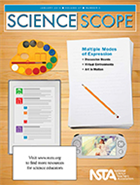 There are many ways students can be motivated in science. Some students have a passion for the subject that goes beyond the classroom. Others may find the types of activities in the classroom to be motivational—working with others, using technology, or having options for how they demonstrate their understanding. This issue features articles that describe a variety of creative ways for students to communicate their ideas and share their knowledge.
There are many ways students can be motivated in science. Some students have a passion for the subject that goes beyond the classroom. Others may find the types of activities in the classroom to be motivational—working with others, using technology, or having options for how they demonstrate their understanding. This issue features articles that describe a variety of creative ways for students to communicate their ideas and share their knowledge.
Blending a science unit on motion with art led to an interesting way for students to communicate their understanding of the concepts. Science + Art = Enhanced Learning Experiences for All Students includes several examples of student expression—what a wonderful opportunity for students to express their learning! With the abundance of visuals in science publications, websites, and apps, students can (and should) be producers as well as consumers of these visuals. [SciLinks: Force and Motion]
Physical activity in science lessons can also be motivating for students, such as the projects described in Stomp Rockets: A High-Impact Exploration of Science Concepts*. [SciLinks: Rocket Technology]
Every Assessment Tells a Story describes a classroom-based action research project on alternatives to traditional tests. In a story assessment, students are presented with a narrative and a set of questions or tasks related to it. After trying these assessments along with more traditional ones, the author discovered that scores of assessments with stories were higher than traditional tests on the same concepts. Students indicated that they felt less anxious with the format. Some students even looked forward to them. Two examples are provided, along with guidelines for creating story assessments.
Standardized Test Questions: A Tool for Developing Students’ Proficiency with the Framework’s Science Practices describes strategies and sources for finding test items that assess higher-level thinking and relate to the NGSS. The authors suggest incorporating these items into everyday instruction, such as in exit tickets, writing prompts, and evidence circles. Exploring concepts through virtual environments is the topic of Engage, Elaborate, Evaluate! Virtual Environment-Based Assessments of Science Content and Practices. The authors provide the links to the modules, including the one on weather described in the article. [SciLinks: Weather and Climate]
Many students and teachers are using electronic discussion boards and forums to communicate. If you need some suggestions on how to begin and manage such a discussion, The Leonardo Strategy: Scientific Discourse and Argumentation in an Online Environment* describes the use of a structured format. The teacher poses a stimulus question with an image and students can respond to the question and to other students’ responses. The authors provide examples of stimulus questions and examples of students’ participation. They also share the results of a study on time spent on participation.
Scientific Explanations and Arguments* (this month’s Teacher’s Toolkit column) describes argumentation as “not simply the generation of a final product, it’s an ongoing dialogue through which scientists build new understanding of the natural world.” The authors compare argumentation as a culminating activity with knowledge building; they provide three examples of exploratory argumentation that they used at the beginning of units of instruction on plate tectonics, evolution, and the particulate nature of matter.
Do you have students that are English language learners? The authors of Supporting Linguistically Diverse Students in an Era of Science Education Reform offer six strategies for working with ELL students (or “emergent bilinguals”—what a powerful description) that focus on what these students can do.
Using Place-Based Inquiry to Inspire and Motivate Future Scientists* integrates scientific inquiry with place-based education (in which students learn through direct experience with an environment instead of indirect presentations or textbooks. The lessons described incorporate typical field trip planning with a 5E model to produce a study ecological study of their school grounds. The article includes project ideas, a sample activity sheet, and rubrics. The resources at the end of the article include suggestions for field guides, safety, and tools for exploring the environment.
Exploring concepts through virtual environments is the topic of Engage, Elaborate, Evaluate! Virtual Environment-Based Assessments of Science Content and Practices. The authors provide the links to the modules, including the one on weather described in the article.
*Check out the Connections for this issue (January 2014). Even if the article does not quite fit with your lesson agenda, this resource has ideas for handouts, background information sheets, data sheets, rubrics, etc.
 There are many ways students can be motivated in science. Some students have a passion for the subject that goes beyond the classroom. Others may find the types of activities in the classroom to be motivational—working with others, using technology, or having options for how they demonstrate their understanding.
There are many ways students can be motivated in science. Some students have a passion for the subject that goes beyond the classroom. Others may find the types of activities in the classroom to be motivational—working with others, using technology, or having options for how they demonstrate their understanding.
Science of the Winter Olympics: Science of Ice
By Judy Elgin Jensen
Posted on 2014-01-17
 The phrase “a level playing field” has a lot of different meanings. But for the skaters, curlers, hockey players, lugers, and bobsledders in the 2014 Winter Olympic Games it means just one thing—ICE. And how is it that all of these athletes can slip and slide over such a surface? Watch Science of Ice from the latest NBC Learn video collection crafted with partner NSF to see if your thinking aligns with current ideas!
The phrase “a level playing field” has a lot of different meanings. But for the skaters, curlers, hockey players, lugers, and bobsledders in the 2014 Winter Olympic Games it means just one thing—ICE. And how is it that all of these athletes can slip and slide over such a surface? Watch Science of Ice from the latest NBC Learn video collection crafted with partner NSF to see if your thinking aligns with current ideas!
The Science and Engineering of the 2014 Winter Olympic Games is a collection of ten short videos focused on the science and engineering design efforts behind Olympic and Paralympic athletes and the tools that each hopes will help them bring home the gold. Use the NSTA-developed lesson plans, available in editable Word format, to spark ideas for incorporating the videos into your course. You’ll find suggestions for activities ranging from bellringers to full-fledged hands-on inquiries.
To get started, watch the video, available cost-free on www.NBCLearn.com and www.science360.gov. Link to it and the downloadable lesson plans at the links below. The Integration Guide suggests strategies for detailing the STEM concepts of the video while the Inquiry Guide supplies BOTH a hands-on science inquiry AND a hands-on engineering design inquiry.
With Miami barely reaching the 60s today and most of the country much colder, there’s no better time than now to shiver your way through Science of Ice. Take a look and leave a comment to let us know what you think!
Video
Science of Ice discusses some of the physical and chemical properties of solid water—ice—and how this substance is produced to optimize performance for a particular ice sport.
Lesson Plans
Science of Ice Integration Guide spells out the STEM in the video and gives you mini-activities and ideas for research, teamwork, projects, and interdisciplinary connections.
Science of Ice Inquiry Guide models a science inquiry into the structure of ice and freezing point depression AND models an engineering design inquiry in which students solve a problem related to the qualities of ice in rinks.
Image of the 2010 gold medalist, Yuna Kim, who will compete in Sochi. Photo courtesy of Queen Yuna.
You can use the following form to e-mail us edited versions of the lesson plans: [contact-form 2 “ChemNow]
 The phrase “a level playing field” has a lot of different meanings. But for the skaters, curlers, hockey players, lugers, and bobsledders in the 2014 Winter Olympic Games it means just one thing—ICE. And how is it that all of these athletes can slip and slide over such a surface? Watch Science of Ice from the latest NBC Learn video collection crafted with partner NSF to see if your thinking aligns with current ideas!
The phrase “a level playing field” has a lot of different meanings. But for the skaters, curlers, hockey players, lugers, and bobsledders in the 2014 Winter Olympic Games it means just one thing—ICE. And how is it that all of these athletes can slip and slide over such a surface? Watch Science of Ice from the latest NBC Learn video collection crafted with partner NSF to see if your thinking aligns with current ideas!
“Teaching Elementary Science with Confidence!”: Featured Strand at NSTA’s 2014 National Conference on Science Education in Boston, MA, April 3–6
By Lauren Jonas, NSTA Assistant Executive Director
Posted on 2014-01-14
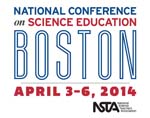 This April, the National Science Teachers Association (NSTA) will feature a special strand “Teaching Elementary Science with Confidence!” at our 2014 National Conference on Science Education, in Boston, April 3–6.
This April, the National Science Teachers Association (NSTA) will feature a special strand “Teaching Elementary Science with Confidence!” at our 2014 National Conference on Science Education, in Boston, April 3–6.
With limited time, resources, and opportunities to learn science, elementary teachers sometimes find teaching science within the school day to be challenging. There is a constant struggle to find the time for engaging students in active science experiences. We also know that simply doing a science activity does not produce a deep understanding of concepts. This strand provides opportunities for elementary teachers to enhance their content knowledge, locate resources, incorporate science and engineering practices from the Next Generation Science Standards, and explore classroom management strategies when teaching science.
Sessions organized around this strand include a featured presentation on Friday, April 4 10:30–11:30 AM (“Chrysalis: Transforming Your Teaching”) by Steve Rich (NSTA Director for Professional Development; Director of GYSTC, University of West Georgia: Carrollton, GA). More sessions on Teaching Elementary Science with Confidence include the following:
- Doing Problem-Based Science Challenges and Managing Your Classroom—How to Do Both Successfully!
- Helping Young Learners Explore Their Universe with PBS LearningMedia
- How Can I Change It and What Will Happen? Identifying Variables with Wind-Ups
- Compost: The “Rot” Thing for Our Earth
- Using Electric Circuit Puzzles for Design and Assessment
- Doing Science the Scientific Way: It’s Not as Hard as It Sounds
- Engineering Made Easy: NGSS Practices for Elementary Students
- All You Need Is 30 Minutes
- Differentiating Science for Elementary Students
- Butterfly Gardening Using Native Plants
- Outdoor Science Lessons: Extending Indoor Curricula in a Way That Excites Students
- How Can I Help? Empowering Students with Citizen Science
- Unhuggable Critters
- Connecting STEM and American History Through Water Wheels
- Wiggly Worms: Active Learning for the Early Grades
- “Nature”-ally Good Science Teaching in Early Childhood Education
- Teaching Ocean Science to Elementary Students Using National Marine Sanctuaries
- Stars and Crafts
Want more? Check out more sessions and other events with the Boston Session Browser/Personal Scheduler.
 This April, the National Science Teachers Association (NSTA) will feature a special strand “Teaching Elementary Science with Confidence!” at our 2014 National Conferen
This April, the National Science Teachers Association (NSTA) will feature a special strand “Teaching Elementary Science with Confidence!” at our 2014 National Conferen
Science of the Winter Olympics: Slopestyle Skiing
By Judy Elgin Jensen
Posted on 2014-01-13
 The count down is on for February 7, the start of the 2014 Winter Olympic Games in Sochi, Russia! Twelve new winter sports will join those we always look forward to watching. Among them is Men’s and Women’s Ski Slopestyle. To the uninitiated, it looks a lot like what teens do on skateboards, but with skis on snow. In it, skiers combine airs and tricks on a 565-meter course featuring rails and a variety of jumps before being scored on execution, style, difficulty, variety and progression.
The count down is on for February 7, the start of the 2014 Winter Olympic Games in Sochi, Russia! Twelve new winter sports will join those we always look forward to watching. Among them is Men’s and Women’s Ski Slopestyle. To the uninitiated, it looks a lot like what teens do on skateboards, but with skis on snow. In it, skiers combine airs and tricks on a 565-meter course featuring rails and a variety of jumps before being scored on execution, style, difficulty, variety and progression.
Explore the science behind the moves with your students using the latest video series—The Science and Engineering of the 2014 Winter Olympic Games—from the partnership of NBC Learn and the National Science Foundation (NSF). This team brings you another series of high-interest STEM videos to stream into your classroom. Each one is around 5 minutes long and jam packed with science and engineering design concepts.
And of course, NSTA is there, too, with suggestions and ideas for integrating the videos into your courses and conducting hands-on science and engineering design inquiries. To get started, watch the video and then download the lesson plans. The Integration Guide supplies myriad ideas for integrating the video throughout your day. The Inquiry Guide supplies BOTH a hands-on science inquiry AND a hands-on engineering design inquiry.
The series is available cost-free on www.NBCLearn.com and www.science360.gov. Download the lesson plans below in editable Word format. Leave a comment to let us know what you think!
Video
Nick Geopper & the Physics of Slopestyle Skiing discusses some of the physics involved in a type of freestyle skiing known as slopestyle.
Lesson Plans
Slopestyle Skiing Integration Guide spells out the STEM in video and gives you mini-activities and ideas for research, teamwork, projects, and interdisciplinary connections.
Slopestyle Skiing Inquiry Guide models a science inquiry into potential and kinetic energy AND models an engineering design inquiry in which students solve a problem related to slopestyle skiing.
Image of a slopestyle skier in action, courtesy of Patrick Hui.
You can use the following form to e-mail us edited versions of the lesson plans: [contact-form 2 “ChemNow]
 The count down is on for February 7, the start of the 2014 Winter Olympic Games in Sochi, Russia! Twelve new winter sports will join those we always look forward to watching. Among them is Men’s and Women’s Ski Slopestyle. To the uninitiated, it looks a lot like what teens do on skateboards, but with skis on snow.
The count down is on for February 7, the start of the 2014 Winter Olympic Games in Sochi, Russia! Twelve new winter sports will join those we always look forward to watching. Among them is Men’s and Women’s Ski Slopestyle. To the uninitiated, it looks a lot like what teens do on skateboards, but with skis on snow.
Science of ice, brief explanation
By Peggy Ashbrook
Posted on 2014-01-11
 For all those who are experiencing the solid form of water or teaching about it, here is a cool video from the National Science Foundation (NSF) about the science of ice. In this short video, athletes J.R. Celski, Britanny Bowe, and Gracie Gold talk about the ice they like and mathematician Ken Golden of the University of Utah explains why the unique surface of ice enables the slide and glide of winter sports. The science is several levels above early childhood understanding but it’s good for teachers to stretch ourselves as we prepare to answer at least part of our students’ questions at an age appropriate level.
For all those who are experiencing the solid form of water or teaching about it, here is a cool video from the National Science Foundation (NSF) about the science of ice. In this short video, athletes J.R. Celski, Britanny Bowe, and Gracie Gold talk about the ice they like and mathematician Ken Golden of the University of Utah explains why the unique surface of ice enables the slide and glide of winter sports. The science is several levels above early childhood understanding but it’s good for teachers to stretch ourselves as we prepare to answer at least part of our students’ questions at an age appropriate level.
The NSF has other videos about the science and engineering of the 2014 Olympic Winter Games. Add your favorite resource about water in any form by commenting below.
Children’s books about using ice:
The Best Figure Skater in the Whole Wide World by Linda Bailey, illustrated by Alan and Lea Daniel (2003 Kids Can Press)
Ice!: The amazing story of the ice business by Laurence Pringle (2012 Calkins Creek)
Ice and People by Nikki Bundey (2000 Lerner Publications Co.)
Ice Palace by Deborah Blumenthal, illustrated by Ted Rand (2003 Clarion)
Happy sliding!
 For all those who are experiencing the solid form of water or teaching about it, here is a cool video from the National Science Foundation (NSF) about the science of ice.
For all those who are experiencing the solid form of water or teaching about it, here is a cool video from the National Science Foundation (NSF) about the science of ice.
Basic Data Literacy: Helping Your Students (And You!) Make Sense of Data
By Carole Hayward
Posted on 2014-01-10
 We are surrounded by data. When you read, watch, or listen to the news, you are presented with the conclusions drawn from data someone else has collected. And they’ve collected that data to understand something, argue a position, make a point, or persuade the listeners to adopt a particular view. It’s important to realize that everyone has an agenda of some sort, and being more data literate helps you understand if others are making a fair argument.
We are surrounded by data. When you read, watch, or listen to the news, you are presented with the conclusions drawn from data someone else has collected. And they’ve collected that data to understand something, argue a position, make a point, or persuade the listeners to adopt a particular view. It’s important to realize that everyone has an agenda of some sort, and being more data literate helps you understand if others are making a fair argument.
Data literacy is an important skill to develop in students, and science classrooms are a good place to do that because data collection and interpretation are part of the science curriculum in most jurisdictions. What authors Michael Bowen and Anthony Bartley realize is that the “challenge in encouraging teachers to do inquiry investigations exists in part because of aspects of data collection, analysis, synthesis, and presentation that teachers of science often just do not know.”
The authors developed Basic Data Literacy: Helping Your Students (And You!) Make Sense of Data after years of presenting workshops at NSTA conferences on this very subject. This book is designed to help teachers and students make sense of data in ways that are conceptually grounded in hands-on practices and reflect how scientists use and present data.
The examples included relate to classrooms and the types of data collection activities that teachers have students do. As every teacher understands, supporting students who are doing laboratory investigations of the student-directed and open-ended type is a considerable challenge and can require a lot more background knowledge than undergraduate teaching programs often provide.
Learning about how to analyze and make better sense of data also helps you learn the best way to collect data. And learning how to collect, summarize, and analyze data is a very important skill, central to the newly released Next Generation Science Standards (NGSS).
Read the sample chapter, Simple Statistics For Science Teachers: The T-Test, Anova Test, And Regression And Correlation Coefficients.
This book is also available as an e-book.
NSTA's K-College Science Education Journals: January 2014 Issues Online
By Lauren Jonas, NSTA Assistant Executive Director
Posted on 2014-01-09
Communicating science—NSTA’s journals are all about it this month—helping children be captivated by the wonders of science, empowering them to share, and making science relevant to students as they grow into responsible citizens. The links below will take you to science education resources written by educators, for educators. NSTA’s January 2014 journals are live online (with select articles being free for all, and full content being free to all NSTA members). Browse these issues for classroom-tested ideas, activities you can use tomorrow, and commentary from experts in the field. And if you feel inspired, please keep the communication flowing in both directions—we’d love your comments on what you liked, didn’t like, and especially on what works in your classroom!
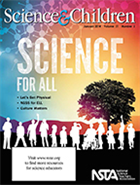 Science and Children
Science and Children
All students must be provided with equitable opportunities to be captivated by the wonders of science. This month’s issue is filled with resources for making science in your classroom engaging, inclusive, and accessible to all.
Featured articles (please note, only those marked “free” are available to nonmembers with out a fee):
- Culture Matters in Science Education
- Free – Editor’s Note: Science for All
- Free – Let’s Get Physical
- NGSS for English Language Learners
- The Power of Multimodal Representations
- What’s the Weather Like Today?
- Full Table of Contents
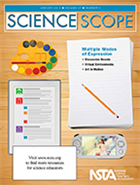 Science Scope
Science Scope
Providing students with a variety of ways to communicate their ideas and share their knowledge helps build their confidence and keeps them engaged. Check out the activities in this issue for creative ways for students to express themselves in the science classroom.
Featured articles (please note, only those marked “free” are available to nonmembers without a fee):
- Free – Editor’s Roundtable: Meet Me in the Middle in Boston
- Engage. Elaborate. Evaluate! Virtual Environment-Based Assessments of Science Content and Practices
- Every Assessment Tells a Story
- Science + Art = Enhanced Learning Experiences for Students
- Standardized Test Questions: A Tool for Developing Students’ Proficiency With the Framework’s Science Practices
- Stomp Rockets: A High-Impact Exploration of Science Concepts
- Supporting Linguistically Diverse Students in an Era of Science Education Reform
- Free – The Leonardo Strategy: Scientific Discourse and Argumentation in an Online Environment
- Using Place-Based Inquiry to Inspire and Motivate Future Scientists
- Full Table of Contents
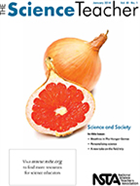 The Science Teacher
The Science Teacher
Teaching science has important implications for human society and the future of our planet. All students will need to make ethical decisions about complex socio-scientific issues that arise as a consequence of new science and technology. This issue of The Science Teacher focuses on bioethical issues such as genetic engineering, access to health care, and personal medical decisions. Students will also need to be able to think critically about energy allocation, individual resource consumption, climate change, access to food, and distribution of scarce resources. By emphasizing these socio-scientific connections, we help students learn important content while developing their ability to make informed decisions about critical issues. This edition of the journal will help you bring the necessary emphasis to your own classroom.
Featured articles (please note, only those marked “free” are available to nonmembers without a fee):
- Free – Career of the Month: An Interview With Ecosystem Scientist Stan Wullschleger
- Classification
- Free – Editor’s Corner: Crosscutting Patterns
- Science Challenge Day
- Science Immersion
- What Makes Us Tick…Tock?
- Free – Where’s That Dolphin?
- Full Table of Contents
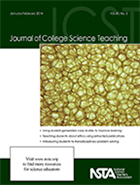 Journal of College Science Teaching
Journal of College Science Teaching
Given the financial pressures faced by many colleges and universities, the hiring of temporary faculty has become more common; read about the challenges and benefits of being an adjunct professor in Ann Cutler’s Editorial and in Robert Liftig’s Point of View. Don’t miss the article on an outdoor environmental project designed to connect with students’ real-world experiences in the Two-Year Community column. And don’t forget to read the Research and Teaching article on a new instructional model that focuses on teaching students to use foundational principles rather than rely on a multitude of facts to improve their understanding of core scientific concepts.
Featured articles (please note, only those marked “free” are available to nonmembers without a fee):
- A Multidisciplinary Laboratory Course in Color Science
- Free – Editorial: Good Help Is NOT Hard to Find
- Introducing Transdisciplinary Problem Solving to Environmental Management Systems and Geology Students Through a Case Study of Disturbed Coastal Systems
- Remeasuring Postsecondary Teaching: How Singular Categories of Instruction Obscure the Multiple Dimensions of Classroom Practice
- Research and Teaching: Collaborative Testing: Evidence of Learning in a Controlled In-Class Study of Undergraduate Students
- Research and Teaching: Principles, First and Foremost: A Tool for Understanding Biological Processes
- Student-Generated Cases: Giving Students More Ownership in the Learning Process
- Free – Teaching About Ethics and the Process of Science Using Retracted Publications
- Teaching Science and Mathematics: Preservice Teachers’ Perceptions of Knowledge Needs
- Full Table of Contents
Communicating science—NSTA’s journals are all about it this month—helping children be captivated by the wonders of science, empowering them to share, and making science relevant to students as they grow into responsible citizens. The links below will take you to science education resources written by educators, for educators. NSTA’s January 2014 journals are live online (with select articles being free for all, and full content being free to all NSTA members). Browse these issues for classroom-tested ideas, activities you can use tomorrow, and commentary from experts in the field.
Science and society
By Mary Bigelow
Posted on 2014-01-09
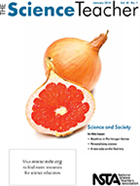
As the editor notes: “All students will need to make ethical decisions about complex socio-scientific issues that arise as a consequence of new science and technology.” So how does this translate to the classroom? The featured articles in this month’s issue describe several classroom-implemented lessons and units that go beyond the presentation of content to including the processes of analysis and argumentation—helping students exmine issues and develop their ability to make informed decisions.
Using popular fiction as a context for evaluating the effects of genetic engineering is the focus of Bioethics in the Hunger Games. The authors provide connections between the book and science concepts. They include assessment prompts aligned with Bloom’s Taxonomy and a chart that could be shared with students on determining the credibility of their sources. The culminating activity is round table format for presenting student arguments. There are suggestions for setting up and using a round table presentation (including a rubric). [SciLinks: Genetic Engineering]
Justifying a position on socio-scientific topics through argumentation is also the featured process in Beyond “My Opinion Versus Yours.” The article includes a strategy called the Silent Debate, in which pairs of students support their arguments by writing on a piece of paper that they pass back and forth. I can see how this idea prevents shouting matches and allows all students to participate, not just the more vocal ones. [SciLinks: Bioethics]
This month’s Green Room column has suggestions for going Back to Ecological Basics. The author’s big picture: To function, all organisms and ecosystems rely on a constant cycling of matter. How can human behaviors affect these cycles? [SciLinks: Water Cycle, Carbon Cycle, Nitrogen Cycle, Phosphorous Cycle]
I was intrigued by the subtitle of A New Take on the Field Trip: A low-tech, inquiry-based virtual field experience. The author describes a process she used to create a virtual field experience that could be replicated for any topic and subject area. She provides a step-by-step procedures for planning, constructing, and sharing the experience. Although her examples feature on earth science, the process could be applied to any content area (a trip inside the cell?). The extension is also interesting: Having students use the process to create experiences. This could be an authentic assessment opportunity. In this month’s Connections the author shares a sample virtual field experience and more suggestions. [Use SciLinks to find graphics, maps, simulations on a variety of topics]
Perhaps students could take a virtual trip to explore Micro World. The article describes a study of microfossils and pollen, and I learned a new word—palynology, the study of ancient or modern pollen from 5 to 500 microns. [SciLinks: Foraminifera, Fossil Pollen]
Personalizing Science includes four lessons and five strategies for engaging students in socio-scientific issues. The author includes a matrix showing how the five strategies mesh with lessons on food choices (nutrition), heart transplants (circulatory system), herbal supplements (organic compounds), and Huntington’s Disease (molecular genetics) and were implemented in core science courses. [SciLinks: Nutrition, Circulatory System, Organic Compounds, Genetics]
Learning about shapes, with tips from a special education teacher
By Peggy Ashbrook
Posted on 2014-01-08
Working in a school with teachers who have a different expertise than I have means I have access to an informal professional learning community’s broader depth of knowledge. Early childhood teachers represent a wide variety of cultures, ages and educational backgrounds. This variety is a strength when we learn from each other.
Sara Fritel Johnson is an early childhood educator with graduate degrees in early childhood special education and reading. She has worked extensively with public and private school children ages 2 to 8 years old. I asked her how I can best support all children’s learning when I model teaching science activities, such as the one on the movement of 3-D geometric shapes in the January issue of Science and Children, and she agreed to be a guest on this blog in interview form. Welcome Sara!
Peggy: When introducing preschoolers to new vocabulary words such as names for geometric shapes, are there any tips for helping children master the pronunciation and remembering the names?
 Sara: Using a multi-sensory approach will help all children. You can use visuals, real materials, whole body movement or smaller movements to help them remember new vocabulary words being taught. I think it is especially important to let them handle the materials – not just watch you as the teacher handling the materials. For example, when you are reading a book, the children can be holding shapes and when you come across “their” shape, they can hold it up or bring it to you.
Sara: Using a multi-sensory approach will help all children. You can use visuals, real materials, whole body movement or smaller movements to help them remember new vocabulary words being taught. I think it is especially important to let them handle the materials – not just watch you as the teacher handling the materials. For example, when you are reading a book, the children can be holding shapes and when you come across “their” shape, they can hold it up or bring it to you.
Peggy: How can we help children who have fine motor difficulty manipulating ramps and rolling objects, or using scissors, participate in these activities?
 Sara: When manipulating ramps and rolling objects, some children can be accommodated by using larger balls (e.g. golf ball instead of marble or 4 inch ball instead of golf ball). If they are having difficulty manipulating ramps, you could hold one end while they hold the other. You could also have children describe how they want them placed and then put them in place using hand over hand assistance (your hand over their hand).
Sara: When manipulating ramps and rolling objects, some children can be accommodated by using larger balls (e.g. golf ball instead of marble or 4 inch ball instead of golf ball). If they are having difficulty manipulating ramps, you could hold one end while they hold the other. You could also have children describe how they want them placed and then put them in place using hand over hand assistance (your hand over their hand).
 When using scissors, if children are having a difficult time snipping paper, you can verbally prompt them “open, close; open, close.” You can also give them hand over hand assistance for this. If they are able to cut, but are having difficulty staying on a line, you can help hold the paper, so they can focus on cutting instead of having to focus on holding and cutting. Eventually, they will be able to use both hands – one for cutting and one to hold the paper.
When using scissors, if children are having a difficult time snipping paper, you can verbally prompt them “open, close; open, close.” You can also give them hand over hand assistance for this. If they are able to cut, but are having difficulty staying on a line, you can help hold the paper, so they can focus on cutting instead of having to focus on holding and cutting. Eventually, they will be able to use both hands – one for cutting and one to hold the paper.
Peggy: What are some general ways teachers can to check ourselves to ensure we are meeting the diverse needs of all the children in our classrooms?
 Sara: Ask yourself – Are all the children participating and are they engaged/having fun? If the answer is “yes,” then their needs are most likely being met. If the answer is “no,” chances are you need to reflect on your lesson and possibly talk to students to see what you can do to support their learning. Sometimes asking students, “How can I help you?” opens up the conversation for them to tell you with what they might be struggling. For example, if you are working on a cutting activity and one student is just sitting there, asking them how you can help will give them the opportunity to say what is difficult for them. If students don’t respond, I usually say, “Let me show you how we can do this,” and then give them hand over hand assistance and give them more independence as they demonstrate more confidence. If the activity is more open ended, I try to get the activity started and then encourage them to try. For example, I might say, “I am going to place a ramp here, where would you like to place the next ramp?”
Sara: Ask yourself – Are all the children participating and are they engaged/having fun? If the answer is “yes,” then their needs are most likely being met. If the answer is “no,” chances are you need to reflect on your lesson and possibly talk to students to see what you can do to support their learning. Sometimes asking students, “How can I help you?” opens up the conversation for them to tell you with what they might be struggling. For example, if you are working on a cutting activity and one student is just sitting there, asking them how you can help will give them the opportunity to say what is difficult for them. If students don’t respond, I usually say, “Let me show you how we can do this,” and then give them hand over hand assistance and give them more independence as they demonstrate more confidence. If the activity is more open ended, I try to get the activity started and then encourage them to try. For example, I might say, “I am going to place a ramp here, where would you like to place the next ramp?”
Peggy: Do you have any suggestions or resources for teachers?
Sara: Having developmentally appropriate expectations for each student is essential.
Occupational therapist and trainer Dr. Marianne Gibbs’ website, Write Out of the Box, offers developmentally appropriate information on fine motor skills. (Check out the Tips and Teacher Feature pages!) Dr. Gibb’s Handy Handout for Parents, is also an EXCELLENT resource for teachers, about building fine motor skills that will later support handwriting.
Children’s singer-songwriter Nancy Stewart has a fun song and game to play that could go along with the January 2014 Early Years column activity. You could change the words as you teach different shapes, from “rectangles, triangles, circles and squares” to “rectangular prisms, cylinders and cubes.”
Peggy: Thank you Sara, for this information and for being a resource for all the teachers you work with.
I appreciate Sara’s help in recognizing the diversity of student needs in the classroom. “Promoting meaningful and inclusive participation of individuals with exceptionalities in their schools and communities” is an ethical principle for all teachers who work with children with exceptionalities, stated by the Council for Exceptional Children.
 As the children and I work with three-dimensional shapes, I remind myself that it takes time to become familiar with any new vocabulary word. Teachers and children may stumble over the words “triangular prism” because they have always said “triangle block” to identify that shape. Posting pictures the geometric shapes along with their names helps readers remember the name and non-readers can refer to a picture.
As the children and I work with three-dimensional shapes, I remind myself that it takes time to become familiar with any new vocabulary word. Teachers and children may stumble over the words “triangular prism” because they have always said “triangle block” to identify that shape. Posting pictures the geometric shapes along with their names helps readers remember the name and non-readers can refer to a picture.
Here are a few suggestions for teacher resources—books and internet sites—with information and activities to engage children in working in three-dimensions:
Books
Building Structures with Young Children (Young Scientist Series) by Ingrid Chalufour and Karen Worth. 2004. Redleaf Press.
More than Magnets : Exploring the Wonders of Science in Preschool and Kindergarten by Sally Moomaw and Brenda Hieronymus. 1997. Redleaf Press.
Thinking BIG, Learning BIG: Connecting Science, Math, Literacy, and Language in Early Childhood by Marie Faust Evitt, Tim Dobbins, and Bobbi Weesen-Baer. 2009. Gryphon House.
Internet
The National Association for the Education of Young Children’s position statement on Developmentally Appropriate Practice (DAP), and a summary of three core considerations of DAP.
Description of how learning about geometry begins in early childhood. Clements,Douglas H. “Your Child’s Geometric World” Investigations in Number, Data and Space, TERC.
Look at these photos with children to get inspiration for building. Mississippi Heritage Trust. 2008. Geometric Shapes in Architecture.
Visit this site to see names and illustrations of 3-D shapes. Pierce, Rod. “Geometry” Math Is Fun. Ed. Rod Pierce. 6 Sep 2013. 5 Oct 2013
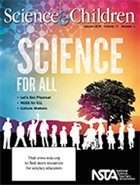 The Early Years column in the January 2014 issue of Science and Children, Shape Exploration-Another Dimension.
The Early Years column in the January 2014 issue of Science and Children, Shape Exploration-Another Dimension.
Sara also shared a game that is a favorite of the children she teaches, “Shape Monster”. The Shape Monster poem is online from several sources as a class book or game. Sara makes shapes – circles, squares, triangles, rectangles in different colors (red, blue, yellow and green) and sizes (big/little). In a 3-D version, the shapes could be balls, blocks, and other geometric shapes. Each child gets a shape or two and then they listen for their shape to be called. The teacher says,
Shape Monster, Shape Monster, munch, munch, munch.
How about a [name of shape] for your lunch?
Each child that has the named shape then gets up and “feeds” the shape monster their shape. The Shape Monster can be a large drawing of a monster face with a wide open mouth, or the children can build a shape monster as they decide where to place their shapes in the center of the circle.
This activity can be differentiated by asking for:
- just a color. (How about a yellow shape for your lunch?)
- just a shape. (How about a triangle for your lunch?)
- just a size. (How about a big shape for your lunch?)
- size and shape. (How about a big circle for your lunch?)
- size, shape, and color. (How about a small, red circle for your lunch?)
- two dimensional (flat) shapes or three dimensional geometric shapes. (How about a sphere for your lunch?)
A fun way to be sure all children are included while learning about three dimensional shapes!
Working in a school with teachers who have a different expertise than I have means I have access to an informal professional learning community’s broader depth of knowledge. Early childhood teachers represent a wide variety of cultures, ages and educational backgrounds. This variety is a strength when we learn from each other.
“Science and Literacy: A Symbiotic Relationship”: Featured Strand at NSTA’s 2014 National Conference on Science Education in Boston, MA, April 3–6
By Lauren Jonas, NSTA Assistant Executive Director
Posted on 2014-01-07
 This April, the National Science Teachers Association (NSTA) will feature a special strand “Science and Literacy: A Symbiotic Relationship” at our 2014 National Conference on Science Education, in Boston, April 3–6.
This April, the National Science Teachers Association (NSTA) will feature a special strand “Science and Literacy: A Symbiotic Relationship” at our 2014 National Conference on Science Education, in Boston, April 3–6.
Attention to literacy is often seen as taking time away from science. In fact, built right into the Common Core State Standards, ELA, literacy can and should be used to enhance the effective teaching of science. Well-designed and integrated science and literacy instruction creates a symbiosis that supports classroom practice and student achievement. The investigation of science concepts within the elementary classroom enhances the development of reading, writing, and communication skills. At the upper grades, strengthened literacy skills continue to empower all students to access the science content and communicate their understanding. This strand will address how literacy and science are in service to each other across the learning continuum.
Sessions organized around this strand include a featured presentation on Saturday April 5, 3:30–4:30 PM (“Reading and Writing Science: What Should Be My Line?”) by Wendy Saul (Professor and Allen B. and Helen S. Shopmaker Endowed Chair, College of Education, University of Missouri–St. Louis: St. Louis, MO). More sessions on Science and Literacy include the following:
- ELL Strategies and How They Relate to Science Achievement Scores
- Closing the Achievement Gap with Constructed Response
- The 4Cs and Science: Incorporating 21st-Century Learning and Innovation Skills into K–12 Curricula
- Get to the Point: Techniques for Downhill Writing
- Liberating Literacy Strategies for Today’s Science Classroom
- Merging Labs and Literature: Exciting Science Lessons Linked to Great Books
- Collaborative Editing of Student Work Online in Science and English Language Arts
- Bringing Primary Scientific Literature to the Classroom Through the Journal of Emerging Investigators
- Telling a Story with Data and Visuals: Critiquing and Creating Infographics in the Classroom
- Teaching Science Through Literacy to English Language Learners and Early Childhood Kindergarten Learners
- Active Reading of Nonfiction Text
- Tricks of the Trade 4.0: Literacy Strategies to Enhance Your Science Instruction
- Discourse—Worth Discussing!
- Expand the Popular Mary Pope Osborne’s Magic Tree House Adventures by Building in Hands-On Science Activities as They Are Read
Want more? Check out more sessions and other events with the Boston Session Browser/Personal Scheduler.
 This April, the National Science Teachers Association (NSTA) will feature a special strand “Science and Literacy: A Symbiotic Relationship” at our
This April, the National Science Teachers Association (NSTA) will feature a special strand “Science and Literacy: A Symbiotic Relationship” at our

